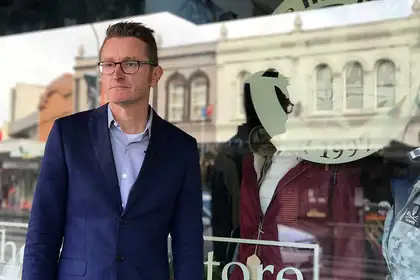
Associate Professor Chris Wilkins says methamphetamine availability in Auckland continues to rise, while prices are declining.
Findings from the latest Massey University Illicit Drug Monitoring System (IDMS) study show increasing availability of methamphetamine in Auckland since 2013, consistent with evidence of growing international supply.
Availability of methamphetamine in Christchurch declined slightly in 2015, following a number of years of rising availability since the 2011 earthquakes, while the availability of methamphetamine in Wellington has remained stable.
Associate Professor Chris Wilkins, leader of the illegal drug research team at the SHORE and Whāriki Research Centre, says the trend of lower wholesale prices for methamphetamine has also continued. “The gram price of methamphetamine declined from $815 in 2011 to $678 in 2012, and has remained at this lower level over the past four years, including in 2015 [$668].
“Increasing availability of methamphetamine and declining prices is indicative of growing international methamphetamine supply in the Asia/Oceania sub-region. There have been record seizures of methamphetamine made at the border in New Zealand and Australia in recent years. The 334 kilograms of methamphetamine seized in New Zealand in 2015 was the highest amount seized in 17 years,” Dr Wilkins says.
The IDMS study, conducted by Massey University researchers, has provided an annual snapshot of trends in illegal drug use and drug markets in New Zealand since 2006. Three hundred frequent illegal drug users from Auckland, Wellington and Christchurch were interviewed about drug trends between August 2015 and February 2016.
Growing gang involvement in methamphetamine supply
The proportion of frequent drug users who purchased methamphetamine from a ‘gang member or gang associate’ has increased from 30 per cent in 2009 to 54 per cent in 2015. There were also recent increases in the number of people who bought methamphetamine from a ‘drug dealer’ – up from 63 per cent in 2014 to 80 per cent in 2015.
The rise of semi-public methamphetamine markets
Dr Wilkins says there has also been a steady increase in the purchase of methamphetamine from semi-public locations such as ‘street drug markets’. “These types of sales are up from 5 per cent in 2009 to 23 per cent in 2015, while ‘public areas like a park’ are up from nine per cent in 2009 to 40 per cent in 2015. Sales from ‘tinny houses’ are up from 11 per cent in 2009 to 24 per cent in 2015, and drug deals in ‘pub/bar/clubs’ are up from two per cent in 2009 to 22 per cent in 2015.
“These findings suggest growing involvement of organised criminal groups in methamphetamine supply and more open public markets for methamphetamine. This is another sign of a rising international supply of methamphetamine,” Dr Wilkins says.
The synthetic cannabinoid ban has reduced availability but a black market has emerged
Dr Wilkins says there were declines in the availability and use of synthetic cannabinoids following the 2014 bans. “The proportion of ecstasy users who had used synthetic cannabinoids declined from 22 per cent in 2013 to six per cent in 2014 and five per cent in 2015. The proportion saying synthetic cannabinoids were ‘very easy’ to obtain declined from 73 per cent in 2013 to 38 per cent in 2015.”
However, he says there is evidence of an emerging black market of more potent synthetic cannabinoid products. “The proportion reporting the strength of synthetic cannabinoids was ‘high’, increased from 14 per cent in 2014 to 59 per cent in 2015. There were increases in the purchase of synthetic cannabinoids from a range of black market locations such as ‘tinny houses’, up from nine per cent in 2014 to 17 per cent in 2015, ‘drug dealers’ up from six per cent in 2014 to 41 per cent in 2015 and ‘gang members’ up from seven per cent in 2014 to 32 per cent in 2015.” Dr Wilkins says 46 per cent of those surveyed were also still purchasing synthetic cannabinoids from ‘legal retailers’ in 2015.
Reports of a “cannabis drought” in southern parts of the country
The proportion of frequent drug users who could purchase cannabis in one hour or less declined sharply in Christchurch (down from 76 per cent in 2014 to 54 per cent in 2015) and in Wellington (down from 63 per cent in 2014 to 43 per cent in 2015). The price of an ounce of cannabis increased in Wellington, up from $279 in 2014 to $331 in 2015 and in Christchurch, up from $327 in 2014 to $353 in 2015.
“These findings are consistent with anecdotal reports by users of difficulties in purchasing natural cannabis and may reflect the rising supply of black market synthetic cannabinoids. A recent study showed that 20 per cent of synthetic cannabinoid users reported reducing or stopping their natural cannabis use,” Dr Wilkins says.
The growing activity of online drug markets
The frequent drug users reported greater use of the internet to buy and sell drugs, including purchasing from social media sites such as Facebook, Tinder and Snapchat (40 per cent) and from encrypted websites (18 per cent). The proportion of frequent drug users who purchased ecstasy from the internet increased from less than one per cent in 2011 to 10 per cent in 2014 and 2015.
“These findings indicate the growing utilisation of online environments for the purchase and sale of drugs. These online drug markets circumvent traditional physical street markets and geographical barriers to supply,” Dr Wilkins says.
Click here to read the full IDMS report.